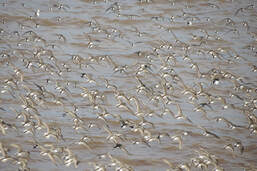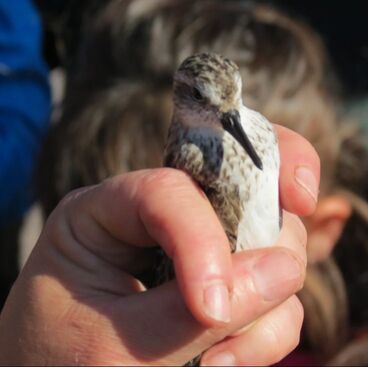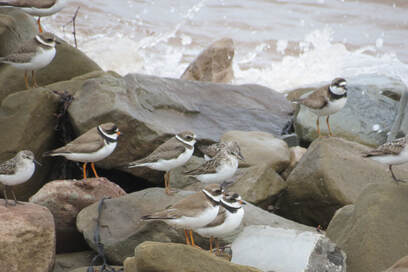
Not the bagpipers, nor the pied pipers, but the sandpipers are the topic of this piece. You see, we are full-on into summer here in Albert County and at the Hopewell Cape Rocks, so I thought it might be time to remind people of the amazing bird migration that will begin around mid-July, peak around mid-August and continue well into September, and even early October.

First some facts (and some speculation) about these birds. They first arrive in our region around mid-July in small numbers and the first to arrive are the females of the species. In recent years, however, the trend is that their arrival has been delayed, probably because of warmer weather in the arctic. Most are flying in from the lower arctic where they have laid three to four eggs. When the young hatch they are precocial, which is a fancy word for the fact that they can look after themselves. They start foraging only hours after hatching. This frees up the females to leave the males in charge after a few days and head out on their migratory route. When the females arrive here in the upper reaches of the Bay of Fundy, their long journey to their wintering grounds in Northern South America (Suriname, Guyana, Brazil, etc.) is about halfway complete.
These birds and their reserves of fat and energy are horribly depleted by the time they arrive. They stay here for around three weeks and do nothing but rest and eat. They eat corophium (tiny mud shrimp about the size of a piece of long grain rice), that are full of the fatty acids that they need. They also eat biofilm, that they scoop up off the surface of the mud, as well as whatever other kind of worm or tiny crustacean that they can find.
The dining takes place when the mudflats are exposed at varying degrees of low tide. At high tide, they roost along the edge of the tide line while waiting for the tide to go out again. This roosting time is vital to their well being and it is important that they not be disturbed during this period. They are, of course, disturbed by various birds of prey, primarily peregrine falcons and merlins. It is not the sandpipers that are caught and eaten by these birds of prey that has the most negative effect on their survival. Rather, the main concern is the number of times that they are forced to take flight and burn energy.
The peeps (as many call them) weigh in at about 20 to 30 grams when they arrive and can double their weight during their three-week stay. They soar up in to the sky when the winds are favourable and fly pretty much non-stop to South America in three to four days.
The males arrive next and then the juveniles arrive, most of them in September. They go through the same routine as the females, until they too set out for their winter home in South America. It is estimated that approximately 30 to 35% of the world’s semipalmated sandpipers come though our region each year.
The return trip to the arctic does not include our beaches and mudflats. Many go through Delaware Bay (between the States of New Jersey and Delaware) in time to feed on horseshoe crab larvae, while others may go through other parts of the eastern seaboard and some through Saskatchewan.
All that information is interesting enough, but without a doubt the most interesting part of this migration for most people is the unbelievable sight of seeing tens of thousands of these birds in flight at the same time. If you have not witnessed this aerial ballet, I urge you to visit the Hopewell Rocks, Mary’s Point or Johnson’s Mills across the bay in early to late August. The coordinated aerial manoeuvres of these birds are breathtaking. Think of a large school of small fish darting instantly this way and that, up and down, right and left without ever bumping into one another. Now picture this being done by small birds, only while airborne. They can soar and dive, merge in to a bulbous smudge in the sky, or string out like a strand of DNA. Add the drama of merlins and peregrines diving and chasing them and it is an unforgettable experience. The truth is that the birds of prey have a low success rate in their quest for dinner, but when they are successful it epitomizes the harsh reality of nature. We can feel sadness for the sandpiper, but at the same time appreciate that nature has been served and that the intricate cycle of life and death is necessary in the grand scheme of things.

P.S. The Shepody National Wildlife Area at Mary’s Point has a new interpretive centre and will be a great place to go to see the sandpipers and many other species.
Paul F. Gaudet is the Interpretive Services and Reception Manager at the Hopewell Rocks Tidal Exploration Site, as well as the Vice-Chairman of the UNESCO Fundy Biosphere Reserve and a freelance writer.
 RSS Feed
RSS Feed